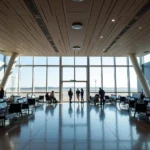Syria, a land steeped in history and culture, is also home to a network of airports that serve as gateways to its diverse landscapes and ancient wonders. While the country’s recent history has impacted its air travel infrastructure, there are still several airports operational, connecting Syria with the rest of the world. This guide provides a comprehensive overview of Syria’s airports, including their history, facilities, and current operating status.
Damascus International Airport (DAM)
Damascus International Airport (DAM), located in the outskirts of Damascus, is the largest and busiest airport in Syria. It served as the primary international gateway to the country until the outbreak of the Syrian Civil War. Although operations have been significantly impacted by the conflict, DAM remains open and handles both domestic and international flights.
History: DAM was originally built in the 1950s and underwent several expansions over the years. It played a vital role in connecting Syria with other countries, promoting tourism and facilitating trade.
Facilities: DAM offers a variety of facilities, including check-in counters, baggage claim, duty-free shops, restaurants, and currency exchange services. However, due to the ongoing conflict, some facilities may be limited or unavailable.
Current Status: DAM operates with limited flight schedules, primarily serving destinations within the region. The airport has been subjected to various closures and disruptions throughout the Syrian Civil War.
Expert Insights: “While Damascus International Airport has faced challenges, it remains a symbol of Syria’s resilience and its continued connection to the world. Its future will depend on the resolution of the conflict and the return of peace to the region,” says Dr. Ahmad Al-Amin, a renowned aviation expert.
Aleppo International Airport (ALP)
Located in the northern city of Aleppo, Aleppo International Airport (ALP) was a major hub for both domestic and international flights before the Syrian Civil War. The airport was severely damaged during the conflict and has remained closed since 2012.
History: ALP was built in the 1960s and played a crucial role in the development of Aleppo as a commercial and industrial center.
Facilities: The airport boasted modern facilities, including check-in areas, baggage handling, duty-free shops, and restaurants.
Current Status: ALP remains closed and its future remains uncertain. Extensive renovations and repairs would be required to restore the airport to operational status.
Latakia International Airport (LTK)
Latakia International Airport (LTK) is situated on the Mediterranean coast, serving the coastal city of Latakia and its surrounding region. While LTK has been relatively less affected by the Syrian Civil War than other airports, it still faces challenges in terms of passenger traffic and flight schedules.
History: LTK was established in the 1980s and served as a vital connection point for tourists visiting the scenic coastal region.
Facilities: LTK offers basic facilities, including check-in counters, baggage claim, and a small selection of shops and restaurants.
Current Status: LTK is currently operational, with a limited number of domestic and international flights.
Other Airports in Syria
In addition to the major airports listed above, Syria has several other airports that are used for domestic flights or military purposes. These include:
- Al-Baath Air Base (ABT): Located near Homs, this airport is primarily used for military operations but also handles some domestic flights.
- Tiyas Air Base (T4): Situated in the eastern part of the country, this air base is primarily used by the Syrian Air Force but has also been utilized for civilian flights in the past.
Traveling to Syria: Important Considerations
While the Syrian Civil War has impacted the country’s aviation infrastructure, there are still opportunities for air travel to Syria.
- Flight Availability: Check flight availability and schedules carefully before booking. Flights may be limited and subject to changes.
- Security: Be aware of security risks and follow the latest travel advisories from your government.
- Insurance: Ensure you have comprehensive travel insurance that covers you in the event of unforeseen circumstances.
- Visa Requirements: Obtain the necessary visas and travel documents well in advance of your trip.
- Currency Exchange: Ensure you have access to local currency before arriving in Syria.
FAQs
Q: Is it safe to travel to Syria?
A: Due to the ongoing conflict, travel to Syria is highly discouraged. It is advisable to refer to the latest travel advisories from your government before making any travel plans.
Q: What are the operating hours of Damascus International Airport?
A: The operating hours of DAM are subject to change and may be affected by the security situation. It is best to check with your airline or airport authority for the most up-to-date information.
Q: What is the best way to get to Syria from the United States?
A: Direct flights from the United States to Syria are currently unavailable. You may need to connect through another country in the region.
Q: What are some popular tourist destinations in Syria?
A: Syria is home to numerous historical sites and cultural landmarks, including the ancient city of Palmyra, the Umayyad Mosque in Damascus, and the Crusader castles in the north.
Q: Are there any restrictions on bringing items into Syria?
A: Syria has restrictions on certain items, including firearms, explosives, and illegal drugs. It is essential to check with the Syrian authorities for the latest customs regulations.
Need Assistance?
For any further assistance or inquiries, please contact us at:
- Phone: +13089626264
- Email: [email protected]
- Address: 404 Bothwell St, Oxford, NE 68967, Hoa Kỳ.
We have a 24/7 customer support team ready to assist you.
